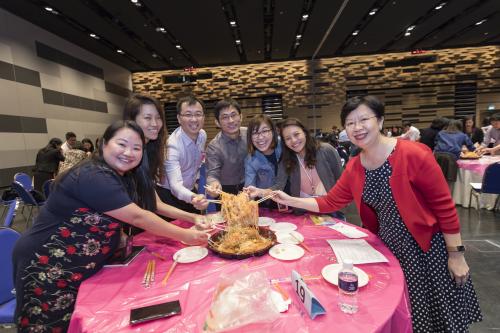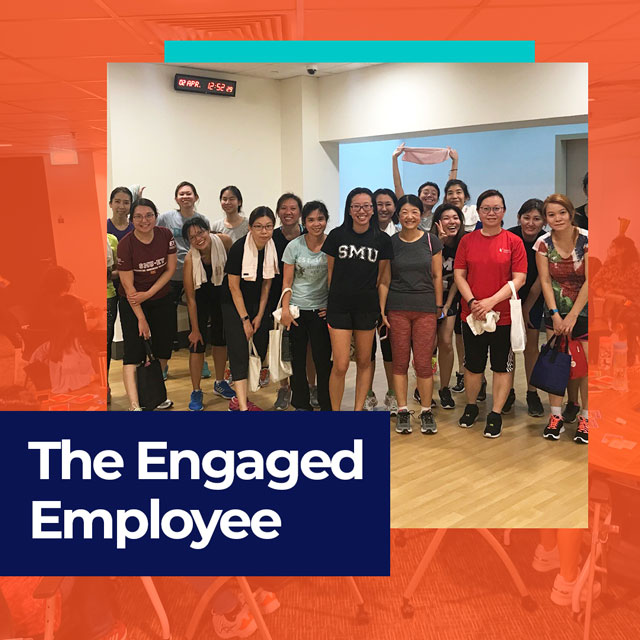SMU Heartbeat: Building a connected OneSMU family
In every organisation, it is the people that make up its heart – and rightly so. After all, when the corporate family feels connected, its members are highly motivated and will remain invested in contributing their best.
Naturally, at Singapore Management University (SMU), it’s not just student engagement that is important; employee engagement is just as critical a driver for well-being, success and productivity, especially in the midst of uncertainty and volatility.
To better understand the sentiments among the staff, SMU introduced SMU Heartbeat in 2020. Thus far, it’s been met with resounding success as the University’s faculty and staff view each session as a welcome opportunity to engage senior leaders on SMU’s strategies and transformation efforts.

Getting to the heart of the matter
The result of a 2018 SMU Employee Engagement Survey (EES), SMU Heartbeat consists of quarterly sessions between the SMU community and senior management that serves as a platform to foster open and transparent communication.
“Heartbeat is designed to be a two-way interactive session to garner feedback ‘from the ground’,” explains Marina Ishak, senior manager, SMU Leadership and Organisational Development. Its aim: To help facilitate improvements in work processes and policies through opportunities for employees to ask questions, understand management perspectives and gain organisational insights, she adds.
So how did it come about? This initiative was based on staff feedback from the ESS not only for more regular, but also inclusive engagement with senior leaders on issues that matter to the university.
“There was a townhall session for administrative staff called Uni Updates, and the Employee Engagement Steering Committee (EESC) commissioned a team to look into its rebranding to meet staff requirements that surfaced,” explains Chua Su San, head of SMU Learning and Organisational Development. The SMU President was also closely consulted on this rebranding exercise, Su San adds.
And unlike previous Uni Updates sessions which were largely focussed on a presentation from the President, SMU Heartbeat events include interactive elements such as games, live quizzes and polls that allow the audience to put forth their views, ideas or feedback.

From offline to online
To ensure that every session is run smoothly, there is an organising committee that works together. This core team is made up of various SMU faculty and staff members, including Employee Engagement Ambassadors, University Social Club, HR, Office of Integrated Information Technology Services (IITS), Office of the President and Corporate Communications.
Furthermore, each member has an important role to play – for instance, Employee Engagement Ambassadors would help to facilitate ice-breakers and support event logistics while the University Social Club would host interactive activities and podcasts, including how SMU has managed the May 2020 pandemic lockdown. Finally, the IITS team would ensure smooth and successful virtual events by offering IT support and being on-hand to troubleshoot any technical glitches during a Heartbeat event.
And while the very first SMU Heartbeat session was an in-person event – a Chinese New Year Lo-Hei for 500 back in February 2020, soon after, the pandemic struck and with enforced social distancing regulations, the SMU Heartbeat sessions had to pivot to virtual platforms.
Yet the committee did not let the challenge sway them. In fact, the first virtual Heartbeat session was held just months after the start of the pandemic.
“There was much confusion, uncertainty and a general sense of restlessness among the SMU community. Everyone was just learning how to use the online meeting platforms and adapting to work from home,” shares Sumathi Nair, senior manager at SMU’s Student Success Centre.
But for Marina, it was even more nerve-wrecking because she had just joined the university. With mandatory work from home regulations, the very first Heartbeat session she had to organise was its inaugural virtual meeting: “It was a steep learning curve for me and the planning committee. We explored a couple of virtual platforms and eventually used BlueJeans for our maiden virtual session.”
To ease the participants during this first venture into the new normal, Sumathi shares that colleagues from the University Social Club were roped in to “conduct a mini icebreaker at the start of the session to lighten the mood” that included polls and even online Pictionary games before SMU President Professor Lily Kong took to the floor.
Jan Setyawan, senior assistant director at the SMU Learning Space Technology, who leads the IITS support team, recalls that the first virtual Heartbeat session as being the most stressful due to the team being new to the process.
“We did a lot of technical try-outs internally, then arranged for three to four rehearsals,” recalls Jan.
“We even arranged a few mock-up sessions for the staff (potential participants) to just try to join, and see if their devices and apps were properly installed and configured to join the actual sessions.”
This was important because unlike the earlier Uni Updates sessions with just President Kong or other members from the senior SMU leadership team speaking, the virtual Heartbeat session incorporated various moving parts, thus rendering the meetings and rehearsals necessary.
Sumathi agrees and adds that even though this took place while everyone was still working from home, the organising committee “was committed to making this a success for SMU so we brainstormed ideas and collectively worked together to ensure that the event went smoothly”.
Perhaps this is why Jan also cites that this first virtual Heartbeat session as being the most memorable. “It was like climbing a mountain that no one has climbed before, and it was a huge unknown on which path would bring us safely to the top. It was the team spirit and mental support of one another that helped us in delivering the event successfully.”
Like Jan, Sumathi also cites the first virtual session as being the most memorable, but for a different reason. “We were rather sceptical that the staff would participate in the games as we were unable to see or hear everyone,” says Sumathi. “Being online made it easy for everyone to hide behind the screen and not participate. However, as soon as we started, the responses came in and so many of the staff participated, making the event a success. We were heartened by the responses and were motivated to keep going till the end. It was a rewarding experience as we received many words of thanks and encouragement.”
Lessons learnt
Though the first virtual session was a success, the committee ensured that they still listened to feedback from the participants to make future sessions even better. This included suggestions to switch to Zoom because “it was more user-friendly” and the participants were “more familiar with it”, says Marina.
In addition, the committee admits that holding virtual sessions have made participation more accessible to the faculty and staff. “We could increase our event attendance unlike in-person where we are limited by event space,” adds Marina. The recent SMU Heartbeat engagement session held on 10th May 2021 saw over 400 participants joining in.
Contrary to popular belief that virtual events are more challenging to organise compared to in-person events, Su San shares that she’s found the reverse to be true. “I found the virtual sessions to be less complex and easier to manage once you get a hold of the virtual platforms and tools to use,” she admits. “You’ll only need a core team of staff (about four to six) to manage a virtual session for 500 people.”
On the other hand, in-person events would require a venue large enough to hold the same number of attendees, and the space would be needed to be secured for a few days to include time for pre-event set-up and post-event tear-down, all of which would add to the costs. In addition, the offline event would also need a larger team, 10 to 12 staff, Su San estimates, to take on duties such as ushering, emceeing, IT support, programme management and catering, to ensure that it runs smoothly.
More importantly, Su San has found that virtual events are just as engaging, if not more, than in-person sessions, thanks to the use of interactive tools, question and answer, and polls during the presentations that help connect the speakers with the staff. She’s found that “more questions, responses and ideas” have surfaced from participants through the virtual SMU Heartbeat sessions than at the face-to-face event.
For instance, an online survey was conducted to garner feedback on what steps would be needed to ensure a safe, healthy, comfortable and productive workplace in SMU, especially in light of the pandemic, and a total of 555 responses were submitted, which was shared during the 10th May 2021 SMU Heartbeat engagement session. In addition, the same session also saw various suggestions being shared by faculty and staff on a range of topics including increasing flexibility in flexi-time and flexi-place policies, conducting hybrid meetings and even sterilisation of the workplace.
As Su San sums up, “The event was so well-received that we knew we were on the right track.”


